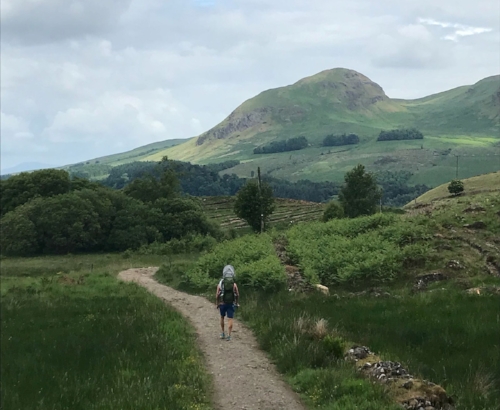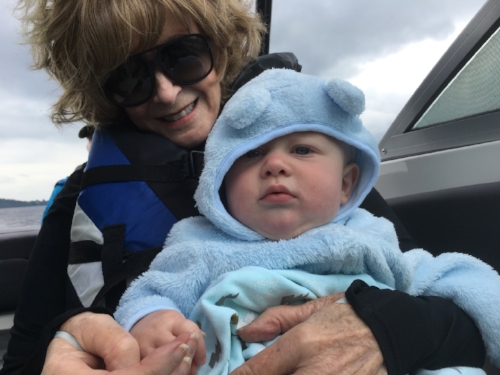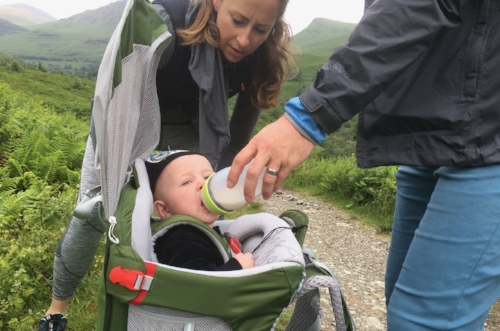Embarking through a rare bit of sunlight
Monday, June 11th, 2018
Our goal is to walk a bunch. We are coming up fast on Dad’s seventy fifth birthday, and he has taken to marking his age with feats of distance walking. He turned sixty-five on the Tour du Mont Blanc, a ten-day walk through Switzerland, France, and Italy. We have photos to prove he was there. I was there too, but blew out my knee on the sixth day, meaning that I am no longer willing to compete with my father for who can walk farther. He can.
The walking starts in a village called Milngavie that is pronounced ‘Mull-Guy.’ Scottish towns, from my brief experience, are named after digestive noises. Other towns on the route include Balmaha (post-prandial muttering), Rowardennan (soda in a full stomach), and Crianlarich (into the toilet bowl). We take a commuter train from Glasgow to Milngavie on which a chatty Scot conductor asks where we are from, and, upon hearing, sets his arm down on the back of the seat in front of us and starts to opine about the Scottish countryside and why people might visit it. During a stop, we observe a man try to sneak onto the train without purchasing a ticket. The conductor observes him too and says chasing down the fee isn’t worth the effort.
My own mapping...
The town of Milgavie is a yuppie suburban enclave with a pleasant high street and a few shops. My sister, Teal, has recently birthed my six-month-old nephew, Jax, and so she buys all of the baby formula and diapers available (British Airways lost her bags), and we embark. The first day is long but reasonably comfortable. We see cattle, we see an abundance of heather, we see sunlight one last time. We march through fields next to a road and stop at a pleasant pub for lunch.
Mark, Jax, and Willa embark
In the evening, we arrive in Drymen (pronounced ‘Drimmon’), where a charming and solicitous couple of innkeepers usher us indoors, and we discover that my sister, Willa, has accidentally stolen the telephone from our hotel in Glasgow, to both her chagrin and the hotel’s.
Tuesday, June 12th, 2018
My mother walked the first day with us, but we are all aware that she will not be able to do most of this trip. She has a bad knee and a bad back and several bad internal organs that aren’t helped by her bad cold. As Tuesday dawns, she decides to seek antibiotics. It is not at all clear that they will help—the cold is likely viral—but she needs something to do during the day while the rest of us walk.
Or, really, the rest of them. I will not be walking on Tuesday since I wake up indisposed. The peculiarities of my indisposition are best left undescribed, save to say that I spent the night Crainlariching and the morning further polluting the pristine Inn bathroom.
This can only mean murder, right?
The health clinic in Killearn is clean, pleasant, and elderly. My mother, at 74, seems to be the youngest patient. When we arrive, Mom waits for a doctor. I can diagnose my own ailment, and so I fall asleep in the waiting room. Then I use the bathroom. Then I fall asleep in the waiting room. Then I use the bathroom. This repeats.
In the evening, a cab driver takes us to a hotel that feels like a communist youth retreat. The sterile building is on a small spot on Loch Loman called Rowerdennan. The bartender makes me a home remedy for stomach pain, which I drink. I also have a sandwich. It does not help. I will not describe or imply the events of the next eight hours.
Wednesday, June 13th, 2018
Rowardennan is not much more than an Inn and a parking lot on the edge of a lake. Because we have booked this trip through a resort-booking company, and because we are all comparatively old, today is a rest day.
At noon, Dad books a trip on a speed boat so that we might all discover the far shores of Loch Loman. They are, as the song suggests, bonnie bonnie. The guide tells us about a wealthy old coot who populated one of the lake’s islands with wallabies. They have bred and gone feral, but we do not see them as we pass.
A form of loch monster
Thursday, June 14th, 2018
From Rowardennan, the trail passes along the shores of Loch Lomand on slippery footing. The rain starts fitfully as we leave but comes steady and sideways as the morning wears on. My brother-in-law, Mark, sets out to run the trail in front of the rest of us. I follow, listening to podcasts and hiking fast. My mother, sister, and six-month-old nephew, Jax, take an-hour-and-a-half cab ride that skirts around the far side of the lake.
Halfway north along the lake’s shore towards Inversnaid, I spot a goat. It will be the only non-cow, non-human, non-dog mammal I see on the walk.
Lunch at the hotel in Inversnaid commences with a bald Scottsman announcing—in the most Scottish of possible accents—that Scottish weather will “make a man of ya.” My appetite for stereotypes fulfilled, I order a ham sandwich.
In the afternoon, the trail climbs out of the lake bed into rolling hills with long grasses. The rain eases slightly, and I push myself to make good time, arriving at the Drover’s Inn by mid afternoon.
The Drover’s was founded two years before Scotland was incorporated into the UK, in 1705. An enormous claymore is situated above the main fireplace and the waitstaff wear kilts. It is said to be haunted by a family who froze to death nearby during the late 1700’s. I stay up late, reading and hoping for a ghost encounter, but am disappointed.
Friday, June 15th, 2018
Friday, like every single other other day, dawns damp and grey. ‘Damp and grey’ could go on a bumper sticker for Scotland. Mark and Teal carry baby Jax in an Osprey backpack designed for infants. It looks like a modernized litter, except carried by a single person rather than a coterie of servants. Jax gurgles and murmurs as we climb away from the Drover’s Inn and march up the River Falloch. He falls asleep midmorning and manages to keep his head at an angle that would be fatal for an adult.
Snack break
After two hours of walking, we leave the trail for lunch, and descend into the non-metaphorical Crainlarich, where we find ‘The Rod and Reel,’ a pub whose floor collapsed long enough ago that no one can remember why they didn’t bother to fix it. The owners have since renovated, bending the benches so that they might fit neatly against the floor as it slopes downward into one corner of the room. Intriguingly, the bar has a pool table.
After lunch, my sisters climb back to the trail, but I take the train to Tyndrum since the afternoon rain has grown percussive. The train passes near a Lochan—a small lake—where Robert the Bruce was said to have hurled his claymore after defeat at the battle of Dal Righ.
Tyndrum, like Crainlarich, has multiple inns and multiple pubs. The Tyndrum Inn, where we stay, will not refrigerate Jax’s formula, earning them the raw hatred of both my sister and brother-in-law.
Saturday, June 16th 2018
Saturday is no less rainy than the rest of the week. My mother has a bad back and cannot carry Jax so I ride with her on a bus from Tyndrum to the Bridge of Orchy, where we situate ourselves in the game room of the Bridge of Orchy hotel, and Jax immediately begins to cry. I carry him upstairs to an empty dining room with a grand fireplace and with tables set with crystal and silver. The hotel here, like so much of rural Scotland, seems like a throwback to an era of comfortable outposts surrounded by difficult roads. I wonder if the stiff formality of British imperialism—“civilized” dinners, pressed white linen, starched uniforms—was formed in the endless English campaigns against the Scots. As Jax nods off to sleep, I stare out the window at the Bridge of Orchy itself, a wide stone arch that straddles the river Orchy before the road leads off into the hills. Around noon, my sisters, brother-in-law, and father arrive, and I switch packs and rain gear with Mark and leave on the afternoon hike.
Not the bridge of Orchy... or particularly reassuring
From the Bridge of Orchy, the path rises sharply through forest. I drift into thinking what it might be like if I were on foot and a squad of horsemen appeared across the valley, riding hard. There would be maybe twenty-five minutes in which to make the wood and hide myself.
After a few false summits, the road descends sharply into Inveronan, where a charming hotel serves us toasted ham, onion, and cheese sandwiches. In the afternoon, the path begins to follow a stony old military road as it gently ascends into bleak, empty hills. It seems there is a footrace today—sodden runners pass back and forth around us. Eight miles from the hotel, we find the start of the race, at the Glencoe Mountain resort. There is an inflatable finishing arc where a single volunteer waits for anyone who has not yet returned. Up a steeply graded parking lot is a small ski lodge where there is a collection box soliciting donations to cover expenses of new snow-making machines. A taxi meets us and carries us to the Loch Leven Hotel, where a clever bartender named Henry tells jokes in poor taste whose punchlines he whispers, lest he offend other patrons.
Above the Bridge of Orchy
Sunday, June 17th, 2018
We have a rest day at the Loch Leven hotel, so I spend the morning sketching our route. In the afternoon, the hotel owner gives us a tour of his small gin distillery. We drink two local brews, one mixed with cardamom and orange peels and the other with allspice. In the evening, we celebrate Dad’s 75th birthday by eating too much.
...and drinking a bit
Monday, June 18th, 2018
The path today ascends the Devil’s Staircase—so named because it was the route that William of Orange’s men used to retreat after the massacre at Glen Coe in February of 1692. The slaughter was the talk of Europe after it happened. William’s men were ordered to billet among members of Clan MacDonald and then slaughter them in their sleep. Thirty-eight men were killed directly, and an indeterminate number of others died of exposure and starvation after William’s men marched up the valley and burned any settlement they could find. The whole affair was prosecuted years later, the chief question being whether it violated a 1587 law that forbade ‘slaughter under trust,’ a crime that is essentially equivalent to the Red Wedding.
The Devil's Staircase is not in this photo
Despite the intimidating nickname, the walk is relatively easy. I hiked ahead and arrived in Kinlochleven by one o’clock. It is a small town with an old church that has been converted into an international ice-climbing training center that includes a refrigerated wall composed of five hundred metric tons of ice.
End of journey
Tuesday, June 19th, 2018
The final day of the trail is, unsurprisingly, rainy. We buy sandwiches at a local grocery store and hike out of Kinlochleven up a steep switchback. Scottland has few mosquitos but is infested with midges. These small, horrible creatures emerge from the plants whenever the rain stops. Since the rain rarely stops, they usually aren’t a problem. Today, though, we get a breath of sunlight as we hike through the forest, and I am suddenly breathing insects. My sister wraps her head in mosquito netting and looks like a bank robber. Soon enough though, the rain starts and the bugs retreat. After a long hike across a bare ridge line, we pass Lochan Lunn Da-Bhra, a small lake with a small island on which MacBeth, the king of Scots from 1040-57 was said to have lived. It is, however, also said that the lake was home to a waterbull that would emerge and kill livestock. This seems particularly curious since there is no mention of the bull being carnivorous. So the people saying these things—as well as those repeating them—are probably not to be trusted.
MacBeth probably didn't live on this island
From Lochan Lunn D-Bhra the road passes through the Nevis forest and then joins an old forestry road that leads down one final hill and onto an unpleasant stretch of highway, which finally arrives in Fort William, where there is a gruesome tourist shop filled with kilts, plastic Loch Ness monsters, and plaid, scratchy scarves. They also have passport stamps asserting you have walked the Way, which—per our goal—we have.
End of trip













